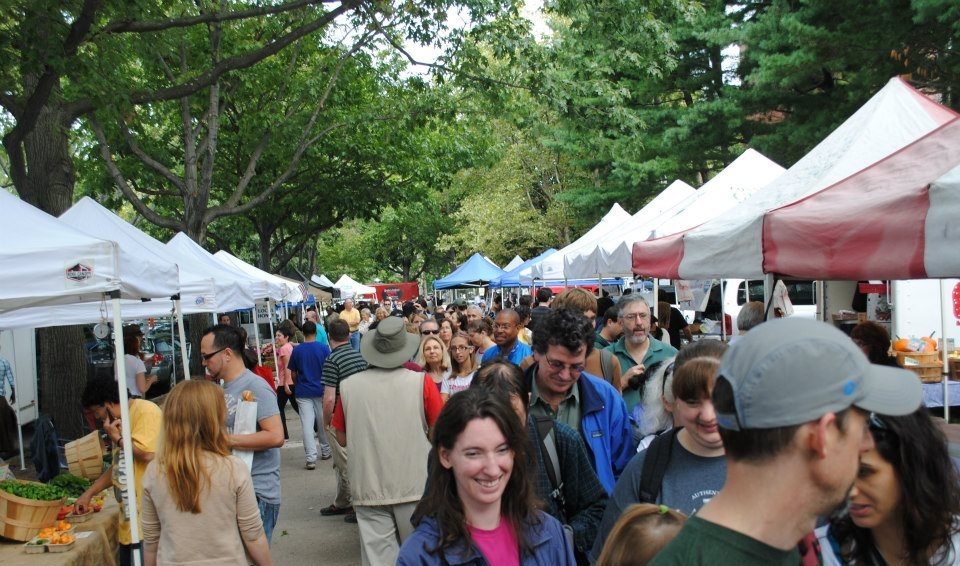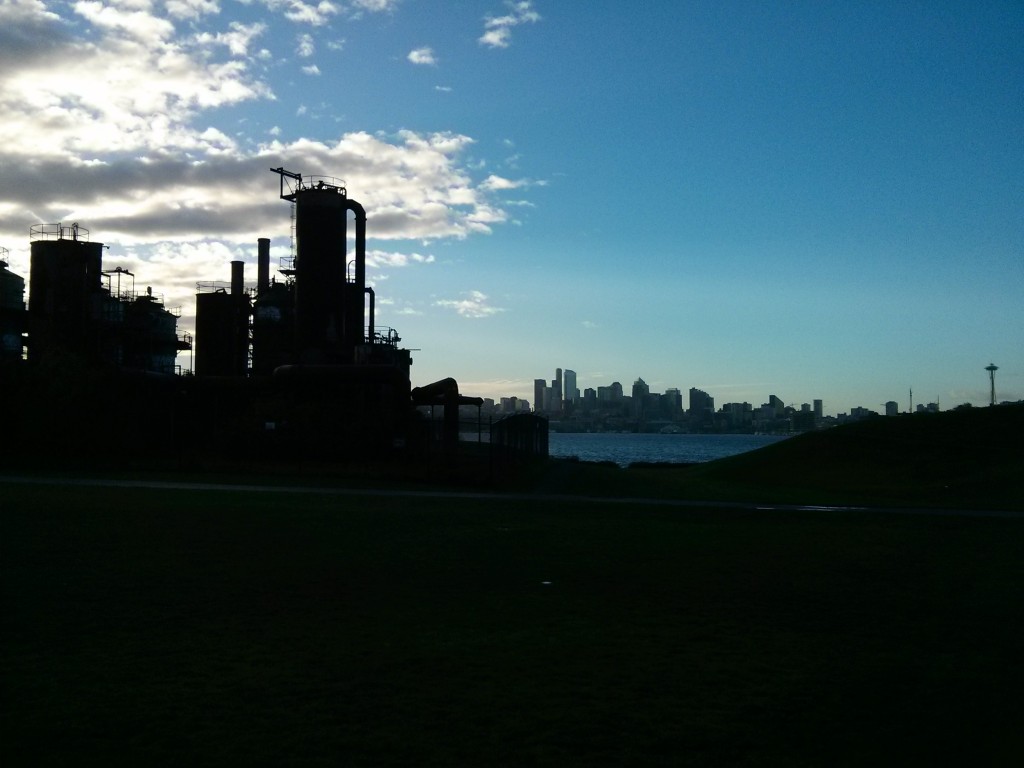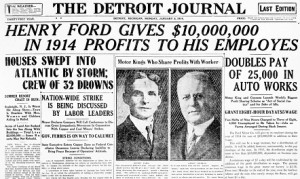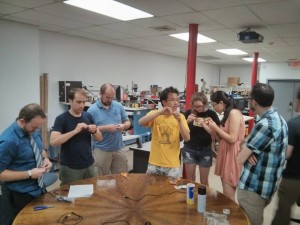This is a story of implementation—bringing ideas to life–and was presented at the AIA Regional and Urban Design Committee One Day Symposium in February 2020 in Austin Texas. Urban development is a labor of love contributed to by many; photos and stories have been credited, but there are hundreds of people responsible for the stories presented here, mostly witnessed during my experience designing and leading the Transformative Development Initiative (TDI) at MassDevelopment Finance Agency 2014-8, and the program continues. The presentation below was a curation of the work of the program to demonstrate the power of people coming together in co-investment. The final sequence is a collage of real stories and sequences from multiple cities, but the entire narrative is also representative of what happened in all of the cities. Some creative license helped assist the flow of narrative with photographs, but all activities and events really happened!
My story is the DIY version of authentic community renewal, and building community and vibrancy from the inside out. To answer the question, “how does it all start—renewal, regeneration,” the answer is the entrepreneur. The entrepreneur might be in public service, private business owner, or a local resident—it doesn’t matter, but what’s important is that every isolated effort be shared and leveraged to build momentum.
The meteorology of a small urban district is endlessly fascinating and fluid. It is the network of flows—economic, social, political—that are unique to each place and provide its opportunity. It is the instance of the physical realm, which captures it, and provides the setting for action, or inaction.

Any one place can ‘stall’—due the shocks or slides due to climatic or economic events. The longer it lasts, it creates a self-imposed and reinforcing lag on prosperity, equity. Despite the assets, and despite repeated efforts renewal, the repeated dashed expectations of a community can further reinforce that stall in the wrong direction. That cloud is hard to shake.

Urban design is what reshapes the physical surroundings, and provides the plan, but it’s the activation of place during and after that plan which is critical for accelerating that trajectory in a virtual cycle of city building.

This acceleration cycle is key to building back the confidence of the community, which if engaged and empowered, then leads to local economic prosperity and wealth building. This cycle is not the disciplined and practiced set of contractual steps in a design project, but a messy and lumpy sequence of projects and persons that evolve into urbanity in spurts.
The work to bring these places to life is PEOPLE powered—and that we must embrace the messy process. But how can designers assure that the plans are implemented once our contract is over?

As designers, it is our job to see the opportunities, ‘tee up’ the idea, inspire, and hopefully further broader support, transforming ‘plans’ into ‘PLACES.’ Historically, these plans were reliant on ‘big promises’ and other grand ideas that have a hard time getting off the ground, and die as quickly. Now, the design team, anxious to present a grounded and realistic approach, struggles to find ‘owners’ of their creative ideas and attain deep engagement in the community.
Accelerating through the stall requires an intentional ‘designer’ in place—an implementer with an eye to curating and connecting a series of unique opportunities into a momentum. It is a person of deep place empathy, with entrepreneurial zeal, to orchestrate and adapt a surgical series of interventions at a PACE and sequence that can truly engage the broadest local community.
This is not ‘what do you want to see in your neighborhood’ outreach or community engagement, but ‘what can you do for your neighborhood.’
Design in this system is a continual response, person to person connecting, sharing enthusiasm, amplifying momentum, and integrating outside flows to the authentic soul and tides of the place. This is building resiliency from the inside out.
Cross Sector PARTNERSHIPS are also key to keep focus and followup and further development of the activation network to include people and entities with influence in the work of the district—the microclimate of the district.
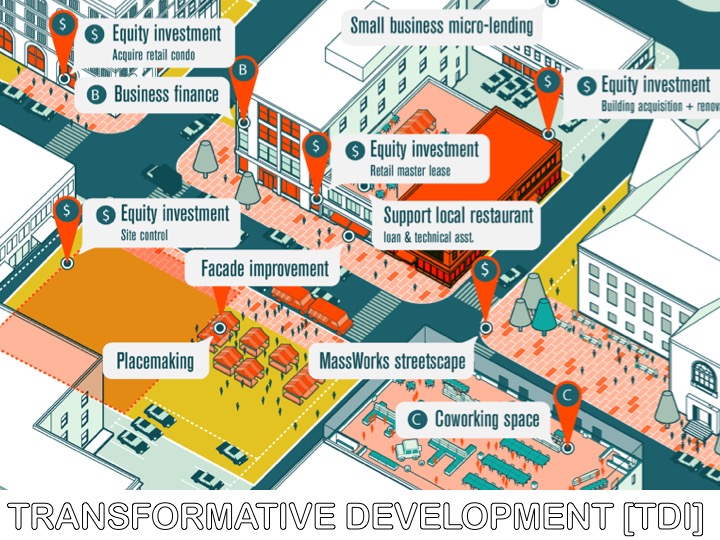
I’ve been focused for the past 15 years on methods for accelerating through that ‘stall’. Most of those years have been in the Northeast, where you see the majority of images in this presentation, to help illustrate the point. This image was developed by my colleague here today, Tim Love at Utile Design, as a means to ‘elevator pitch’ a program I developed at a state economic development agency.
The program was set up as a platform, with a variety of tools that could work at different scales of implementation, and leverage additional local support. The key to the program was our full time ‘fellows’ who were the magic in the mix—a dedicated person for three years, the connector and curator of the district, and builder of partnerships that owned the implementation workplan.
This image captures the ‘assembly’ of all of the various tools and efforts coming together to provide the net effect. Although they are small efforts, in aggregate, there is big change. This is an ethos of little data, not big, and a communication flow of that data that is person to person. This is a ground game focused on hits, not runs, and a free zone for taking risk and trying things.
Most importantly it requires a culture shift—one from coordination to co-investment
In Massachusetts, as of two years ago, 10 million dollar investment was leveraged with over 38 million local dollars in ten cities, and assisted another 80 million to be invested. The renewed local reputation and increased economic activity in these places have now been celebrated locally and highlighted regionally.
In our model, dollars invested become leveraged with other local dollars, and the co investment in place catalyzes shared ownership and accountability of the future. The local co-investment provides new businesses, housing, and increased local spending, further reinforcing the foundation of the place’s future.

This approach won’t happen without the people, and their serendipitous collisions in the urban spaces that we love and design.
The human capacity, and their ideas and inspirations, integrations, are the secret sauce. Yes, there were investments and money involved, but without the human, the investments and related economic development would never have been realized.
The following sequence is a collage of real stories and sequences from multiple cities, but are also representative of what happened in all of the cities. They have all happened in your cities too—but sometimes hard to notice how they build on each other to create the cities we want to be in—not just for the physical environments that are animated, but because of the resilient and vibrant communities that they create.
Where you might mistake these images as trendy placemaking activities that tend to populate many an urban design plan, the story I’m telling is what’s behind the picture, the ‘HOW’ it happened, ‘WHY’ it was important to the place economy, and ‘WHAT’ can you do to position your ideas into action:
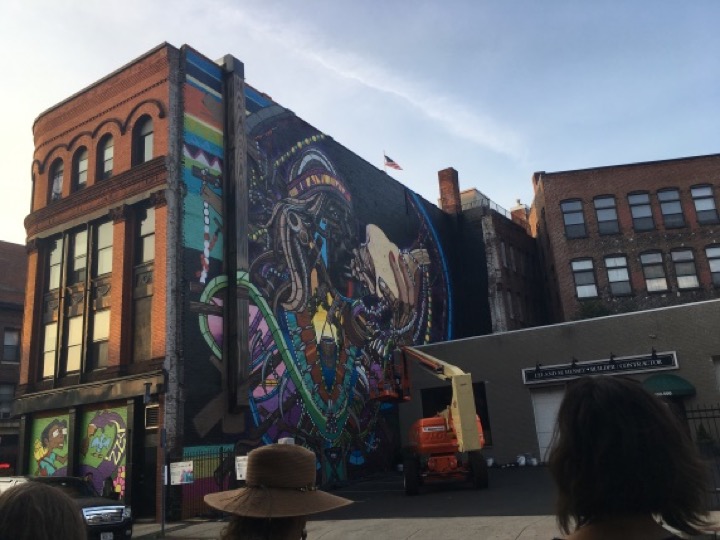
A building becomes a canvas and a long maligned district sets sail—the idea starts at a planning worksession, where a local champion sees an example from another place, and builds the team to launch a mulit-year festival raising over 250,000 in a few months, and engaging local residents by selecting artists that come from the countries that they come from. A groundswell of champions emerge empowered to own the change in their city,

A local institution, when invited to be more involved in a district by a partnership, installs a new culinary program that brings a new anchor activity to a vacant building, and more foot traffic to the district. New Funding for the program was secured due to increased communication about what was going on in the district, countering a negative perception that the district had.

The district fellow connects the institution and their new program with a workforce strategy that aligns to the city’s vision, and finds the money across three organizations. Container farms are purchased and located in a nearby lot, further ‘signaling’ positive change.

The lot hosts a weekly market, initiated by a local entrepreneur who realized that by leveraging the greens grown in the container, they could also host other food producers and local farms. The market incubates more businesses, the market provides enough income to support itself, and becomes a weekly gathering place for the community.

Inspired by the district activity, a local resident opens up a community maker space in a vacant space after meeting the building owner at the market. This space is open after the school’s hours, and is slowly turning the ephemeral activity into a permanent presence. A discounted rent is provided as the owner likes the idea of nighttime activity to keep lights on in the area. A non-profit community organization, that provided a small grant to host activities in the makerspace, relocates from an upper floor in another nearby district to be closer to the action.

People start to occupy a nearby plaza at lunch, as the culinary program starts to produce meals for local workers and residents. The partnership buys tables and chairs. They do not disappear overnight.

The partnership invests in remodeling a space in a partially vacant school, and helps support a group of entrepreneurs that have been meeting informally weekly at the community makerspace. They received a community innovation grant for the renovation, which allows the organization of entrepreneurs to focus on building the community.

Looking for good coffee, an entrepreneur from the co-working space tests a temporary café outside of the coworking space by engaging a coffee shop’s catering from a nearby town. He crowdfunds enough money to build a few structures that can be rented and deployed in other places. A local brewery sees the parklet and suggests a temporary beer hall for a few nights to see if they should open a tap room (they don’t, but they tried).

The coffee shop manager sees enough business at the parklet, and opens up in a vacant storefront nearby with temporary lease. That café decides not to open a permanent space after a 60 day trial, but a non profit service agency hears about the opportunity from the fellow. They takeover the space, invest workforce training dollars to help support the operations and new staff who have new jobs.

The café operator, seeing some nighttime events at the nearby library, buys a tabletop pizza oven, and tries dinner service. The city provides a small storefront improvement grant to install better night lighting, and is excited about the possibility of new restaurants. They copy/pastes an idea for a restaurant financing loan from another city based on research from the district fellow.

The café operator and chef of nearby restaurant, inspired by the new dinner service, and supported by the district fellow, host a ‘restaurant industry night’ to showcase available kitchen opportunities (prior vacant restaurants), available new financing from the city, and the community of food people in the region attend.

A regional developer, coming for the industry night, inspired, invests in a vacant building in the district within a few months. The developer was attracted by the momentum building, and the visible signs of community driven renewal. The developer, connecting with the district fellow, finds other local entrepreneurs to lease space in the building as soon as possible, and even before the housing is finished above. ‘a vibrant street is my amenity package’ he says. New jobs are created, and both local and new residents move in upstairs.

The City feeling emboldened by this activity, invests in streetscape improvements, and in the park that were identified years ago in a planning study. These improvements were so visibly complemented by all the other activity, that the capital improvement request sails through city council.
I think you get the picture….
The virtual cycle continues, and given the ongoing culture of investment, the dollars continue to circulate locally. New life, new businesses with new jobs, new housing, new ideas, all at the support of the people that are connecting in this vibrant place which has accelerated out of the stall, and into a new chapter.

Thanks to the TDI Fellows who finally helped me see how powerful the people-power of community economic development really is, and who demonstrated amazing passion, creativity, and resilience for taking on an adventure of a career: Noah Koretz (now Director of Transformative Development which continues), Joe Mulligan, Laura Masulis, Sika Szedro, George Durante, Jim McKeag, Insiyah Bergeron, as ably supported by Laura Barrett Chistopher and Andrew Levine. Supreme thanks goes to Marty Jones, former CEO of MassDevelopment who was able to trust and believe that we could accomplish something extraordinary. Additional TDI collaborators mentioned here were Beyond Walls founder Al Wilson, TDI Adjunct Fellow Pedro Soto, Worcester’s Deadhorse Hill Chef Jared Foreman, New Bedford EDC’s Angela Johnston and Groundwork Sarah Athenas, and Dave Traggorth of Traggorth Companies. Finally, it wouldn’t have been in existence without the great work of Ben Forman at MassInc and the Gateway Cities effort, as well as Richard Henderson, Tania Hartford, and RJ McGrail. There were so many more of those not mentioned, and many photos not included, that are the champions and entrepreneurs of the Gateway Cities. Thanks!
